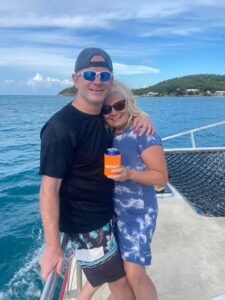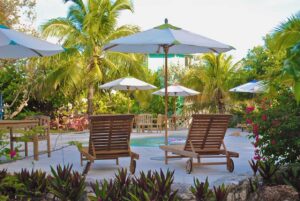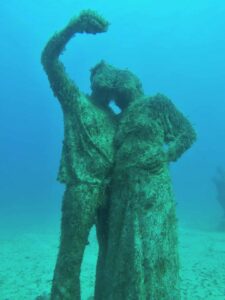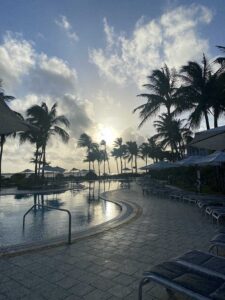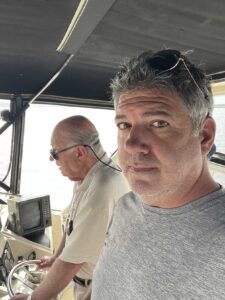
“Might as well get going” said my dad as we stood on the dock, fresh out of things to prepare. I laughed to myself and replied, “Yeah, I guess we might as well.” That conversation plays out in my head every time I set out on a boat — a sign that all preparations are complete, and it’s time to start the trip.
When my father asked me to help him deliver his Hatteras 40 from Charleston to Cape May via the ICW, I jumped at the chance to return to a special place in my life (I spent my summers in Cape May growing up) and spend bonding time with my dad. But I was not without apprehension. It would be my first trip on the ICW, his first in years, and the first on a new-to-him vessel. While I spend a lot of time on the water as a sailor, the twin diesels of the Hatteras were new to me.
As we were about to push off, dolphins showed up, easing the inevitable start-of-voyage jitters that accompany any trip. As we turned into Charleston Harbor and pointed toward the markers at the entrance to the first portion of the waterway heading north, our three dolphin friends escorted us through the channel markers. I took it as a good sign.
Starting Point: Charleston, SC
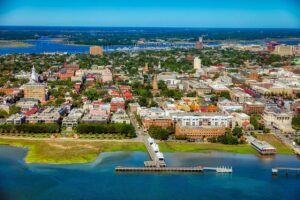
Estimated Mileage: 48 NM
We were warned that the first stretch of waterway was known for scattered shallow spots in the first few miles, but we found none. As waterfront homes of Sullivan’s Island and Isle of Palms slowly peeled away to reveal the quiet wilderness of the Santee Coastal Reserve, I thought, “This is the ICW I imagined.” Pristine, undeveloped and peaceful.
In the coming days, I would learn this was only part of the story. We pulled into Georgetown for the evening, and our first day was behind us. With that came the simple lesson: the only way to get over the nervousness of a trip is to start the journey. We slept well that night knowing we had done so.
Leg 1: Georgetown, SC to Southport, NC
Estimated Mileage: 72 NM
Leaving Georgetown and heading north up the Waccamaw River, the previous afternoon’s tranquility continued. The soft light over the marshlands showed that ours was the only wake in sight, save for a few passing southbound boats. It was an easy way to start the day. And then … Myrtle Beach … on a Saturday… in June. The morning peacefulness gave way to a bustling stretch of waterway filled with all sorts of people enjoying the day — center consoles, water skiers, kayakers, stand-up paddlers, floating tiki bars. Mile after mile of developed waterfront checked our speed and changed our perspective.
Eventually, we cleared through the beautiful chaos of Myrtle Beach, crossed into North Carolina and preceded toward that night’s destination, Southport, NC. This was our first time experiencing the wonderful ICW phenomenon of just pulling over to dock on the proverbial “side of the road.” We settled into the facing fuel dock at Southport Marina and marveled at how the ICW contains multitudes of experiences.
Leg 2: Southport to Beaufort, NC
Estimated Mileage: 83 NM
The weather was mostly settled with morning showers, and thunderstorms were predicted, but clear skies were forecasted for the afternoon. Only on Day 3, we still were under the misguided illusion that the schedule was ours to keep. We wanted to cover some ground today, so we ducked out of the well-marked and relatively easy Masonboro Inlet for an “outside” run up the Atlantic to Beaufort, NC.
As we approached the Inlet, a local Sunday morning sailing race was underway. Half the fleet made it out of the inlet with us before we heard on the radio that the race committee was recalling the fleet due to approaching thunderstorms. We debated staying inside, but the weather quickly passed us, and we rode the gentle swell up to Beaufort Inlet. It was good to get in the miles by going outside the ICW, but we realized that was not the point of this trip. Leaving the ICW, we missed the variety that the waterway provides. We stayed “inside” for the rest of the trip to enjoy the view.
Leg 3: Beaufort to Belhaven, NC
Estimated Mileage: 50 NM
On a trip up the ICW, you discover it’s anything but a highway. Leaving Beaufort, we noted how the waterway that we experienced thus far was a straight-line narrow cut with land close by on either side, often called the proverbial “ditch.” But the ICW also provides moments of wide-open beauty.
Heading out of Beaufort and north up Adams Creek, the ICW gives way to the relative vastness of the Neuse River and Pamlico Sound. Navigation aids are more spaced out, and the wind waves have more room to gather up. We traveled a short stretch of the Sound, pulled into beautiful Belhaven Marina for the night and found the sleepy but utterly charming town was a great place to stop.
Leg 4: Belhaven to Coinjock, NC
Estimated Mileage: 58 NM
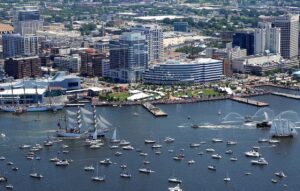
Years of boating taught me that you seldom go five days without seeing weather that you’d rather not see. The past four days were pretty good weather-wise, so we were due for something else. Pulling out of Belhaven in light sprinkles and overcast skies, we entered the famed Alligator-Pungo River Canal. This is truly “the ditch” — 21 miles of a virtual straight line that connects the Pungo and Alligator Rivers. It is narrow and long, and it helps to see where you are going.
Fortunately, the weather cooperated, and we navigated the canal with ease. But just as we emerged into the wide-open Alligator River, heavy rains and stiff squalls closed in around us. I’m always nervous with weather, but my dad has a measured demeanor, so he put me at ease. We picked our way from buoy to buoy and emerged from the storm just as we passed through Alligator River Swing Bridge and started across Albemarle Sound for the evening’s destination, Coinjock Marina & Restaurant. Here I learned the real lesson of the day — order the prime rib!
Leg 5: Coinjock, NC to Norfolk, VA
Estimated Mileage: 34 NM
On every trip, you reach a point where you’ve gone over the hump. With five days of ICW behind us, we hit that point and could sense a change coming. We left Coinjock and picked our way across the long, shallow Currituck Sound into Virginia. As we wound our way through the meandering and pristine North Landing River Natural Area Preserve, both of us were excited to make Norfolk that evening and enter the Chesapeake for our final stretch. Several bridges are on this stretch of the ICW, but our timing was good, and we passed each without much wait.
Sliding through the Great Bridge Locks, we approached Norfolk. The city and its surrounding waterways’ bustle was an absolute eye-opener after the past few days. It made the pace of Myrtle Beach seem bucolic. We slept well, knowing that we had come to mile zero on the ICW safely.
Leg 6: Chesapeake Bay: Norfolk, VA to Chesapeake & Delaware Canal
Estimated Mileage: 200 NM
If approaching Norfolk from the south is eye-opening, then traveling into the Chesapeake past the heart of the Naval docks is something else entirely. Mile after mile of grey steel. More naval ships that I’d ever seen in one place. Amazing! And just like that, you pass over Hampton Roads Tunnels, enter the Chesapeake and you’re back to wide-open beauty.
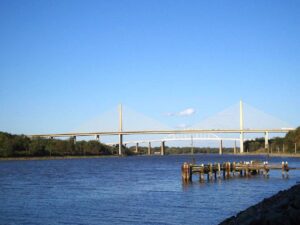
Our time in the Bay was a bit rushed. I had to return to commitments at home, so we had to get in some miles now. The plan: proceed to Solomons for a night and then reach the C&D Canal. However, our optimistic timetable did not stop the Chesapeake from dealing us a few lessons along the way.
The Chesapeake does not care about your schedule. The weather was too crummy in Solomons to leave, so we wisely decided to stay an extra day. When we finally poked out of the Patuxent River, we realized the residual effects of the rain was still evident. The Bay delivered a wild ride, with wind, rain, short chop and limited visibility for a few hours. We pondered cutting our day short, but the weather lifted quickly. By the time we passed Annapolis, blue skies and flat seas surrounded us all the way to the C&D Canal. It was amazing how quickly and dramatically conditions on the Bay changed for the better.
Leg 7: Chesapeake City to Cape May, NJ
Estimated Mileage: 54 NM
After transiting the C&D Canal and entering the Delaware Bay for the final stretch, we were truly in “home waters.” But despite the time I spent on the Bay growing up, I had never navigated a boat down this tricky body of water. The Delaware is busy, with a narrow channel and many big working boats. We hugged the channel’s edge as we made our way down the Bay leaving ample room for others.
As the bay widened out, we plotted our approach to Cape May Harbor. Our entry took us through the Cape May Canal and into the harbor, then on to the boats’ summer berth, not far from where I had spent my childhood summers. With the trip virtually complete, we experienced the bittersweet feeling of nearing our destination. And the final stretch provided perhaps the best lesson of all: When you get the opportunity to bring a boat from one place to another with your old man, take it.


